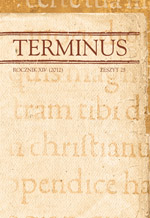Tres turres sunt tres arces... Rola toruńskiego herbu w poezji Ulryka Schobera
Tres tres sunt tres arces… – The role of Toruń coat of arms in Ulryk Schober poetry
Author(s): Elżbieta ChrulskaSubject(s): Language and Literature Studies
Published by: Wydawnictwo Uniwersytetu Jagiellońskiego
Summary/Abstract: Emblem was one of the most characteristic art forms of the Renaissance. Emblem Books were especially popular in the end of the sixteenth century and wielded an unusual influence on literature, especially in combination with younger stemmata. In order to get support from a wealthy patron, poets often wrote poems in which the symbolic interpretation of a coat of arms became a pretext for praise, however it was not always so. This article deals with an interesting example of making use of an emblem (or stemma) as means of persuasion. The emblem in question is also a rare example of the use of persuasion in connection to an urban (and not one of the nobility) coat of arms. Taking into account the historical and religious context, one can read works of Schober more accurately. What is particularly valid is the influence of mayor Henryk Stroband. The ideological content of the poems was subordinated to policy of the city, and, on the other hand, to religious insulation, as a result of the progress of the Counter-Reformation in the Kingdom of Poland, and the concerns it brought about in the predominantly Protestant Torun. By referring to Stroband thought that „felix civitas quae tempore pacis timet bella,” and by use of his interpretation of Torun coat of arms, Schober tried to convince inhabitants to take responsibility for the security of the city, not only in practical terms – by building walls, but also more existential ones – by learning to cooperate. To summarize, these poems are not merely an allegorical interpretation of Torun coat of arms. They reach far beyond the typical interpretation of stemma and also contain instructions for a particular vision of the city, which was to be implemented in Torun at the end of the sixteenth century.
Journal: TERMINUS
- Issue Year: 14/2012
- Issue No: 25
- Page Range: 179-189
- Page Count: 11
- Language: Polish

